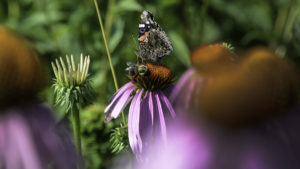Wright “Bee” Flyer
It’s National #PollinatorWeek and yes, we have a bee variety named “Wright Bee Flyer.” As if that isn’t amazing enough, the first written eye-witness account of the Wright brothers’ first flights wasn’t syndicated or published by a popular national paper. It was written by a beekeeper in a magazine he published for other beekeepers called Gleanings in Bee Culture.

Photo by Miami Conservancy District
You may have heard of this beekeeper, or at least of his lasting legacy, Root Candles. Amos Ives Root was an Ohio manufacturer of beekeeping equipment and was “one of the best-known figures in the world.” Through his inventions, he commercialized beekeeping on a practical level and was passionate about technology. Of the Wrights’ invention, he stated it “may outrank the electric car, the automobile, and all other methods of travel, and one which may fairly take a place beside the telephone and wireless telegraphy.” Four years later, mainstream journalists and engineers echoed his opinion.
Here are a few excerpts from Amos’ original article on January 1, 1905:
For 32 years I have been ransacking the world ― that is, so far as I could consistently ― watching periodicals of almost every sort, and leaving no stone unturned to furnish information of interest and value to the readers of Gleanings. I have especially tried to have our own journal up to date in scientific matters; and until the past summer I have made haste to present at once to our readers every bit of information I could get hold of. In short, I have had no secrets whatever that I have withheld. But for the first time in my life, during the past summer I have been under a promise of secrecy. When the Wright brothers kindly permitted me to be present while they were making preliminary experiments they especially desired I should keep to myself, at least for the time being, what I saw. 1 recognized the justice of it, and of course assented. But it was a very hard task for me to keep my tongue ― or pen ― still when I knew the great outside world knew so little (or nothing) of what was going on. Scarcely a dozen people in this whole universe knew what I knew, but I could not tell it. I have thrown out some hints, you may remember, of what was going on. But one of the brothers suggested, “The best way to keep a secret is to avoid letting anybody know you have a secret to keep.” We are told it is hard for women to keep a secret, and I think I must be to some extent feminine in my make-up. Well, just before Christmas my heart was made glad by a letter informing me that, as the experiments for 1904 were probably ended, I might tell the world what I knew about the flying-machine, and therefore I have been made happy. Yes, today, Dec. 26, I am not only enjoying a happy Christmas but I feel just like saying, “A merry and a happy Christmas to you all.” I hope you will enjoy my story about the flying-machine ― as much as I enjoyed being out in that big field with the Wright brothers many times during the past summer and fall, watching that wonderful creation of the hand and brain of those two men, while it “learned to fly,” very much as a young bird just out of the nest learns by practice to use its wings. A picture of the flying-machine up in the air will appear in our next issue, nothing preventing. We could not get it ready for this one.
On the Wrights:
I am now going to tell you something of two other boys, a minister’s boys, who love machinery, and who are interested in the modern developments of science and art. Their names are Orville and Wilbur Wright, of Dayton, Ohio. I made mention of them and their work on page 241 of our issue for March 1 last. You may remember it. These two, perhaps by accident, or may be as a matter of taste, began studying the flights of birds and insects. From this they turned their attention to what has been done in the way of enabling men to fly. They not only studied nature, but they procured the best books, and I think I may say all the papers, the world contains on this subject. When I first became acquainted with them, and expressed a wish to read up all there was on the subject, they showed me a library that astonished me ; and I soon found they were thoroughly versed, not only in regard to our present knowledge, but every thing that had been done in the past. These boys (they are men now), instead of spending their summer vacation with crowds, and with such crowds as are often questionable, as so many do, went away by themselves to a desert place by the seacoast. You and I have in years past found enjoyment and health in sliding down hills on the snow ; but these boys went off to that sandy waste on the Atlantic coast to slide down hills too; but instead of sliding on snow and ice they slid on air. With a gliding machine made of sticks and cloth they learned to glide and soar from the top of a hill to the bottom ; and by making not only hundreds but more than a thousand experiments, they became so proficient in guiding these gliding machines that they could sail like a bird, and control its movements up and down as well as sidewise.
On Flying:
At first there was considerable trouble about getting the machine up in the air and the engine well up to speed. They did this by running along a single-rail track perhaps 200 feet long. It was also, in the early experiments, found advisable to run against the wind, because they could then have a greater time to practice in the air and not get so far away from the building where it was stored. Since they can come around to the starting-point, however, they can start with the wind even behind them; and with a strong wind behind it is an easy matter to make even more than a mile a minute. The operator takes his place lying flat on his face. This position offers less resistance to the wind. The engine is started and got up to speed. The machine is held until ready to start by a sort of trap to be sprung when all is ready; then with a tremendous flapping and snapping of the four-cylinder engine, the huge machine springs aloft. When it first turned that circle, and came near the starting-point, I was right in front it; and I said then, and I believe still, it was one of the grandest sights, if not the grandest sight, of my life. Imagine a locomotive that has left its track, and is climbing up in the air right toward you ― a locomotive without any wheels, we will say, but with white wings instead, we will further say ― a locomotive made of aluminum. Well, now, imagine this white locomotive, with wings that spread 20 feet each way, coming right toward you with a tremendous flap of its propellers, and you will have something like what I saw. The younger brother bade me move to one side for fear it might come down suddenly; but I tell you, friends, the sensation that one feels in such a crisis is something hard to describe. The attendant at one time, when the rope came off that started it, said he was shaking from head to foot as if he had a fit of ague. His shaking was uncalled for, however, for the intrepid manager succeeded in righting up his craft, and she made one of her very best flights. I may add, however, that the apparatus is secured by patents, both in this and in foreign countries; and as nobody else has as yet succeeded in doing any thing like what they have done I hope no millionaire or syndicate will try to rob them of the invention or laurels they have so fairly and honestly earned.
Secondary Source from the Wright State Special Collections and Archives: Tobin, James, “The First Witness: Amos Root at Huffman Prairie” (2001). Following in the Footsteps of the Wright Brothers: Their Sites and Stories. 7. https://corescholar.libraries.wright.edu/following/symposium/program/7
Original Root article sourced from: https://www.pbs.org/wgbh/nova/wright/reporter.html
The current version of Gleanings in Bee Culture: https://www.beeculture.com/
Starting your own Pollinator Project? Here are some facts from Miami Conservancy District:
Benefits of growing a native prairie meadow
- Plants can help filter stormwater runoff before flowing into bodies of water.
- Native plants can add critical habitat, including food and shelter, for birds and other wildlife.
- Meadow areas are places where rain can infiltrate into the aquifer and replenish groundwater reserves.
Saving time and money
- Areas planted with plants, shrubs, and trees can mean less maintenance.
- Removing turf areas can reduce the time spent mowing.
- Native plants may only need mowed once or twice a year.


